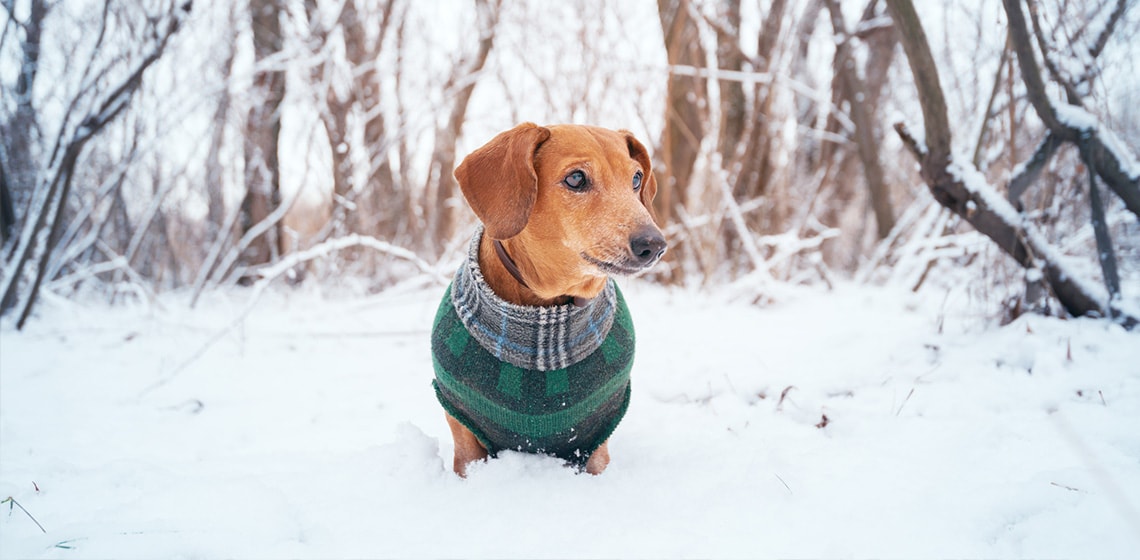Table of Contents
Do Dogs Get Cold During Winter?
Like humans, dogs are susceptible to seasonal changes and can get cold during the winter. All dogs need to be protected from cold weather but some dogs are more tolerant of the cold than others.
Several factors influence how effectively a dog can thermoregulate and keep warm in cold environments. For example, considerations like a dog’s breed, age, activity level, and pre-existing health conditions all contribute to how well a dog copes with cold weather.
These are some signs your dog may be feeling too cold:
- Shivering, shaking, trembling
- Hunched posture or tucked tail
- Hiding in warm places in the house (e.g. under a blanket, near a heater)
- Lethargy or sleeping more
- Skin that is cold to the touch
- Whining
- Reluctance to walk outside
- When on a walk outside: seeking shelter, lifting paws off the ground
Risks of Cold Weather
One dangerous condition dogs are at risk for in cold weather is hypothermia or low body temperature. A normal rectal body temperature for a dog is between 99.5 to 102.5 degrees Fahrenheit. When a dog’s body temperature drops below the normal range, he is at risk for heart arrhythmias, respiratory depression, decreased immune function, neurologic effects, and more.
Another potential complication from exposure to cold weather is frostbite. Frostbite occurs when a body part freezes, causing tissue death. This can occur if a dog’s body temperature drops to 93 degrees Fahrenheit or lower, an exposed body part freezes, or if he touches cold liquid, glass, or metal.
One of the ways to prevent hypothermia and frostbite is to use protective clothing like a winter coat to help keep your dog comfortable outside.
Which Dog Breeds Need a Winter Coat?
Some large dog breeds with thick coats are more resilient in the cold and may not necessarily need a winter coat. Specifically, Northern breeds like the Siberian Husky and the Alaskan Malamute are bred to withstand cold climates, which is reflected by their dense fur coats. But not all dog breeds are designed to handle cold weather.
The following types of dogs may need a winter coat:
- Small and toy breeds: Animals lose heat through their skin. Because small and toy breed dogs have a greater surface area to body mass ratio compared to larger breeds, they also lose heat at a faster rate. Therefore, small and toy breed dogs like Chihuahuas and Yorkshire Terriers are less adapted to cold environments.
- Breeds that are low to the ground: Breeds like Dachshunds and Welsh Corgis are known for their adorable short legs but this puts them lower to the ground. This low profile makes them more likely to touch snow and ice when walking outside.
- Dogs with fur that is clipped or shaved: Dog breeds like the Poodle and Bichon Frise have thick curly coats but are often groomed. If your dog is clipped or shaved, she has less fur to protect and insulate her from the cold.
- Short-haired breeds with lean bodies: Whippets and Greyhounds are examples of short-haired breeds that may be more susceptible to the effects of winter. This is because these lean dogs have less fat to insulate them from the cold.
Senior Dogs and Dogs with Medical Conditions
Senior dogs and dogs with certain medical conditions may also require a winter coat.
Like older humans, senior dogs become less effective at regulating their body temperature as they age. Older dogs are less able to conserve heat effectively. Additionally, elderly dogs do not generate heat as well. This reduced capacity to thermoregulate is partially due to the decreased muscle mass observed in older dogs. All of this ultimately makes senior dogs less tolerant of cold weather.
Certain medical conditions can also affect a dog’s ability to thermoregulate. For example, dogs with hypothyroidism have a slower cellular metabolism, which makes it difficult for them to maintain an appropriate body temperature. Dogs with diabetes mellitus may also have impaired thermoregulation, resulting in a lower body temperature.
Orthopedic conditions like osteoarthritis are often exacerbated by cold weather. These dogs may become stiff, reluctant to move, or lethargic in colder temperatures.
How to Choose a Winter Coat for Your Dog
So now that you’ve decided your dog needs a winter coat, how do you choose the right one for your pup?
- Keep ’em Covered: A winter coat should cover your dog from his neck to the base of his tail. It should also cover the chest and part of the belly without interfering with urination. Make sure the winter coat is the appropriate size and fits your dog well. If it’s too big, the coat will not insulate your dog as effectively and your dog could trip over it. A winter coat that is too small can lead to mobility issues and skin irritation.
- Safety first: When choosing a winter coat for your dog, avoid anything with loose zippers or buttons. Your dog could chew these off and ingest them, which could cause choking or a foreign body obstruction.
- Stay Dry and Warm: Finally, your dog’s winter coat should also be made of waterproof material. This is crucial because a wet coat will make your dog colder.
- Dress for the Occasion: Your dog should only wear his winter coat when he’s outside. Wearing a heavy waterproof winter coat indoors may make your dog overheat. When he’s indoors, you may opt for a lighter t-shirt or sweater if he seems cold.

Dr. Amanda Takiguchi received her Doctor of Veterinary Medicine degree at Colorado State University. After that, she completed additional training at Texas A&M through a small animal rotating internship. Prior to veterinary school, Dr. Takiguchi studied dance and business management at Columbia University in New York City. She primarily works with dogs and cats but also loves exotic species like rabbits. Her favorite animal that has worked with is the native Hawaiian owl. When she is not promoting animal welfare, Dr. Takiguchi still loves to dance, with training in multiple styles including hip hop, ballet, and tap.








